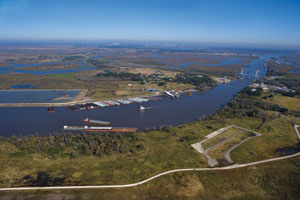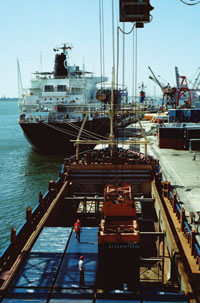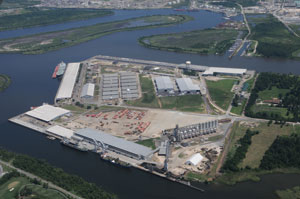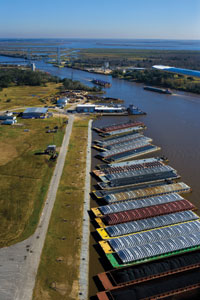Flanking the western Gulf Coast and the Texas border, the five-parish region known as Southwest Louisiana is entrenched in the maritime industry. Six ports operate in the area, offering everything from deep water to river access, along with abundant connections to rail and trucking. Thanks to the Southwest Louisiana Port Network, businesses can easily move their goods – and the raw materials needed to make them – in and out of the area, connecting seamlessly to the rest of the world.
 This strategic advantage hasn’t gone unnoticed, especially by those wanting to transport petroleum, liquid natural gas (LNG) and petrochemical products, as well as raw materials like aluminum, barite, food items and a host of other cargoes. The area is also known as the “oil patch,” with many companies in the region supplying offshore oil rigs or associated in some way with the oil and petrochemical industries.
This strategic advantage hasn’t gone unnoticed, especially by those wanting to transport petroleum, liquid natural gas (LNG) and petrochemical products, as well as raw materials like aluminum, barite, food items and a host of other cargoes. The area is also known as the “oil patch,” with many companies in the region supplying offshore oil rigs or associated in some way with the oil and petrochemical industries.
This port network is made up of the Lake Charles Harbor and Terminal District (commonly called the Port of Lake Charles), the East and West Cameron Ports, the West Calcasieu Port, the Mermentau River Harbor and Terminal District and the Vinton Harbor and Terminal District. Created two years ago, the Southwest Louisiana Port Network has streamlined communication and forged even more productive working relationships among the ports.
It’s no wonder that the word “port” is part of support.
“Our corner of the state is blessed with a strong lineup of progressive ports. Most folks are well aware of the Port of Lake Charles, which is the country’s 11th largest port. But, we also have the others, each with its own niche. For the past two years, all six ports have worked closely together within the Southwest Louisiana Port Network,” said Lynn Hohensee, Port Director at the West Calcasieu Port. “The Southwest Louisiana maritime industry is in a better position to react to opportunities in concert, rather than separately.”
 The ports definitely have the backing of the state. Louisiana Governor Bobby Jindal recently signed House Bill 215, the Ports of Louisiana Investor Tax Credit, which gives private investment at ports a five percent tax credit.
The ports definitely have the backing of the state. Louisiana Governor Bobby Jindal recently signed House Bill 215, the Ports of Louisiana Investor Tax Credit, which gives private investment at ports a five percent tax credit.
“But in order to qualify, the company has to provide family-wage jobs with benefits,” explained Dan Loughney, Director of Marketing and Port Operations at the Lake Charles Harbor and Terminal District. “The program has already been successful at helping economic development at the ports.”
Each with their own niche.
While each the ports is working together to drive economic activity in the area, each offers a different part of Southwest Louisiana’s intermodal equation.
Lake Charles Harbor and Terminal District
As one of the top 15 ports in the nation based on movement of tonnage, this deepwater port is also one of the largest in the U.S., and as such, is vital to the region. The Port of Lake Charles is 34 miles north of the Gulf of Mexico and intersects the 40-foot deep Calcasieu Ship Channel and the Gulf Intracoastal Waterway, a 1,000 mile-long inland waterway that runs from Carrabelle, Florida, to Brownsville, Texas.
According to Loughney, one-third of U.S. oil reserves are in Lake Charles and 12 percent of all LNG comes through the Port of Lake Charles. The fourth largest refinery, CITGO, is also located there.
The port recently received a huge piece of business, a $1.6 billion project to build Lake Charles Cogeneration, a clean energy petroleum coke gasification plant that began construction in 2009 on port-owned property.
Another huge business win for the port is a project by Shaw Fabrication and Manufacturing Group, a Baton Rouge-based Fortune 500 company that will build modular components for new and modified power plants, the first such facility in the nation.
“Shaw chose this location because of its deep-water access and proximity to several different modes of transportation—rail, truck and barge—which were critical as we made the determination to locate the facility here. We also assessed the access to a workforce with the skillsets we needed,” said Jack Martin, Senior Vice President of Shaw Modular Solutions and Structural Steel Operation. “The workforce offers the right skillsets we need, from welders to painters to crane operators to the administrative staff necessary to run the facility efficiently.”
According to an economic impact analysis performed by Louisiana State University, the Shaw project will result in $17.8 billion in new sales, $4.5 billion in new earnings and 9,205 total new Louisiana jobs, including indirect jobs, over 15 years.
East and West Cameron Ports
 The East and West Cameron Ports in Cameron Parish are both vital economic engines to the area. The West Cameron Port is located on the Gulf of Mexico with deepwater access and shallow draft capabilities, while the East Cameron Port has access to the Gulf through the Mermentau River estuary. They play integral roles in commercial fishing and manufacturing, as well as oil and gas service and exploration.
The East and West Cameron Ports in Cameron Parish are both vital economic engines to the area. The West Cameron Port is located on the Gulf of Mexico with deepwater access and shallow draft capabilities, while the East Cameron Port has access to the Gulf through the Mermentau River estuary. They play integral roles in commercial fishing and manufacturing, as well as oil and gas service and exploration.
Ernest Broussard Jr., AICP/CEcD, Executive Director of Planning and Development for Cameron Parish said, “The ports in Cameron represent more than 60 percent of the income stream for the community are the primary economic indicator in the Parish’s overall health.”
The port is in the midst of a $20 million dredging project to further increase its competitiveness, and is home to two LNG plants, valued at $1 billion each, that are soon to experience another $4 billion worth of expansions between the two.
One of those is Cheniere Energy Inc. which operates the Sabine Pass LNG Terminal on the Sabine River on the Texas-Louisiana border. The company will construct the new Creole Trail LNG Terminal on the Calcasieu River in central Cameron. Upon completion, the firm will have the capacity of 7 billion cubic feet per day.
“We consider Cameron Parish to be critical. The area will play an increasingly important role as a supply hub for America’s natural gas needs,” said Meg Gentle, CFO of Sabine Pass LNG.
Another business that finds the area advantageous is Martin Midstream, which operates full service terminals at the East and West Cameron Ports. The Cameron locations provide service to the oil companies and their offshore operations.
“We’re located here because lots of industry runs out of this area and we have deep water access,” said Dwight Savoie, Area Manager of Martin Midstream Partners LP. “Cameron Parish as a whole is doing everything they can, including dredging the East Fork and the Loop."
West Calcasieu Port
 West Cal, as the port is known, is strategically located on the Gulf Intracoastal Waterway, halfway between New Orleans and Houston.
West Cal, as the port is known, is strategically located on the Gulf Intracoastal Waterway, halfway between New Orleans and Houston.
“As a shallow-water port, we are truly services-based. We provide barge fleeting operation support,” said Hohensee. “West Cal has maritime diesel repair support and construction support companies here, and we’re in talks with other companies that the maritime industries need, such as bulk fueling and barge cleaning.”
Devall Towing is the largest tenant at the port, providing shallow water barge transportation support. A recent addition is F. Miller Construction, a subsidiary of the Orion Marine Group of Houston, which joined the port in 2009.
“They use barges to move cranes and large amounts of equipment needed in a variety of marine construction projects from dredging projects to construction of bridges and maintenance of infrastructure,” said Hohensee.
Mermentau River Harbor and Terminal District
Located along the Mermentau River and connected with the Intracoastal Canal, this port serves as a lifeline to the shipyards and oil refineries located along its shores. The port’s cargoes include aggregate, fertilizer, rough rice and rice hull compost, rice and soybeans. Situated one mile north of U.S. Highway 90, the terminals and facilities located along the port include Port Aggregates, Acadiana Export Service, Mid State Sand and Gravel Company and Diamond B. Construction and Bunge.
Vinton Harbor and Terminal District
After a period of inactivity when the port’s land was leased to accommodate small tugboat manufacturing and steel fabrication companies, the Vinton Harbor and Terminal District has experienced growth and activity over the past 10 years. It has recently seen the construction of a $10 million pre-stressed concrete bridge girder and pile facility. Located on a navigable waterway seven miles north of the Intracoastal Canal, tenants of the 320-acre port include Performance Blasting and Painting Company and Dunham Price Group.
Opportunities abound for port-based business in Southwest Louisiana.
From lucrative financial incentives to community support, the Southwest Louisiana Port Network has been working overtime to bring business to the area. Property tax abatements and Gulf Opportunity Zone (GO Zone) Bonds make the port an attractive location for capital-intensive projects like Shaw and Lake Charles Cogeneration.
“This area still qualifies for more than $1 billion in GO Zone allocations in tax-exempt financing,” said Mike Dees, general counsel and head of real estate for the Port of Lake Charles. “These bonds have very low interest. That is a real incentive for industries to locate in our area.”
And ultimately, it’s the cooperation and support of the ports and area leaders that will further drive the growth of business in Southwest Louisiana.
“The ports are working together to meet our customers’ needs. Whether you’re looking for barge or deep water cargo, we can accommodate,” said George Swift, President/CEO of the Southwest Louisiana Economic Development Alliance.


There are no comments
Please login to post comments